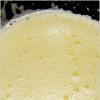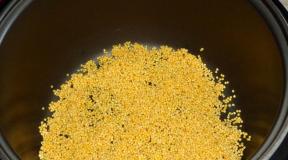Ethiopian wolf: what does it have in common with the jackal? Ethiopian jackal See what "Ethiopian wolf" is in other dictionaries
The Ethiopian wolf is also called the red jackal or Ethiopian jackal. This animal is endemic to Ethiopia. Red jackals live in the African Alps.
Initially, the species belonged to jackals, but after DNA tests it was found that Ethiopian wolves are related to gray wolves.
Description of the Ethiopian wolf
Externally, Ethiopian jackals differ from other jackals in the size of their muzzle and smaller teeth. The body length reaches 100 centimeters, and the height at the shoulders is 50-60 centimeters. Males are approximately 20% larger than females. Males weigh 15-19 kilograms, and the body weight of females ranges from 11 to 14 kilograms. The tail is fluffy, 25-33 centimeters long. The paws are long.
The body color of red jackals is reddish-golden, the belly is white. There are white spots on the muzzle, the base of the tail is also white, and the tip is black.
Lifestyle of Ethiopian jackals
Red jackals live in mountainous areas, in alpine meadows and heaths with short grasses. They are found at altitudes from 3000 to 4300 meters.
Ethiopian wolves are diurnal and are also active at dusk. Adults and juveniles sleep in large groups, curling up into a ball.
Adult wolves check the boundaries of the territory and mark them. The wolf family has established social connections, and when they meet, members of the group greet each other noisily.
Ethiopian jackals make dens along the ledges of rocks and cliffs. If the burrows are in grassy areas, they have several exits.
The main prey of red jackals are rodents, they make up about 90% of the diet. Predators look for African grass rats, giant mole rats and hares. And the rest of the diet consists of small antelopes, such as nyala antelope and reedbuck.

Ethiopian wolves hunt rodents not in groups, but individually, which distinguishes them from other pack predators. Hares and young antelopes can sometimes be hunted together in small flocks. The hearing and vision of these predators are excellently developed, thanks to which they can detect prey in open areas. They can also dig victims out of the ground. They bury the remains of their prey in the ground or cover it with plant debris.
Often these predators compete for food with wild dogs, but the main enemy is humans. The lifespan of Ethiopian wolves is 8-9 years.
Subspecies of Ethiopian wolves
Scientists distinguish 2 subspecies of red jackals:
C. s. Citernii live in the southeastern part of the valley; Rift
Canis simensis simensis are found in the northern part of the valley.

Social structure of red jackals
These predators exhibit unusual social behavior. They live in family groups of 6-13 individuals, and the members of the group are closely related to each other. A pack of red jackals typically consists of the following individuals: about 6 adult wolves, 1 to 6 yearling wolves, and 1 to 7 pups.
Males do not leave their flocks after puberty. About a third of the males are dominant, and the rest are subordinate, but the subordinate individual after the death of the alpha male can take his position. Some females leave their pack and wait for the dominant female to die, then they try to take the place of the main female and begin to reproduce. Among adult females, approximately a third are also alpha females, and females in a subordinate position do not have the opportunity to mate.

Members of the flock constantly mark the boundaries of their territory with feces and urine. They also use visual cues, such as scratching trees and howling. Red jackals are capable of making several types of sounds. When unfamiliar individuals meet, they begin to howl, and this song ends with squeals.
Breeding Ethiopian wolves
Only dominant females have the right to continue the race, and the remaining females help raise the babies. The female occupies a dominant position until her death. After this, her daughter, a beta female, begins to reproduce. Often the main female mates with males of neighboring flocks to prevent inbreeding.
The female constructs several burrows for childbirth in caves, under rocks, and sometimes in the open. The same dens may be used annually. When one den becomes contaminated, the female and pups are placed in a new den. Red jackals give birth to offspring once a year. Pregnancy lasts approximately 60 days.

An Ethiopian wolf litter contains 3-7 puppies, which weigh from 200 to 2500 grams. The coloring of babies is dark, and they acquire adult colors at the age of 3 weeks. The female practically does not leave the babies, so other family members feed her.
After about 20 days, the babies begin to leave the den and explore the nearby territory.
The female feeds the puppies with milk for 4-6 months. But at 5-10 months she already feeds the young with regurgitated food. At the age of 5 months, young individuals already accompany adults on the hunt. Ethiopian jackals reach puberty at 2 years of age.
The benefits and harms of Ethiopian wolves for people
Red jackals do not threaten domestic animals, but in some areas of their range people still pursue these predators. These animals are carriers of rabies and can therefore be dangerous to humans.

Red jackal population status
Ethiopian wolves are a rare species listed in the International Red Book. The number of red jackals ranges from 300-500 individuals.
The main threat to the population is habitat loss, which is associated with the development of sheep farms, agriculture and road construction. Also, Ethiopian wolves die from various diseases: canine distemper, rabies, and the like. The extinction of the species also occurs as a result of the crossing of jackals with local dogs and the birth of hybrid individuals.
If you find an error, please highlight a piece of text and click Ctrl+Enter.
Range: Mountains of Ethiopia north and south of the Rift Valley.
Phylogenetic analysis using DNA suggested that C. simensis is more closely related to the gray wolf (C. lupus) and coyote (C. latrans) than to any African canid species, and that the species may have evolved from the gray wolf, and his ancestors crossed northern Africa from Eurasia 100 thousand years ago.
The largest member of the genus in Africa. Differs from C. anthus, C. mesomelas, C. adustus in its larger size, relatively long legs, peculiar reddish fur and white lower body, throat, chest and tail markings.
Medium in size with reddish fur, distinctive white markings, long legs, and an elongated snout reminiscent of a coyote. Males are significantly larger (20%) than females in body weight.
The general coloration is reddish-brownish (ocher to rusty red), with a dense whitish to pale ginger undercoat. The throat, chest and underparts are white. The boundary between the red fur and the white markings is sharp and well defined. A white stripe is visible around the ventral part of the neck. Long, slender legs are reddish on the outside and white on the inside. The area around the anus is white. A short tan stripe running along the top of the tail becomes black in a thick brush of black guide hairs. The face, the upper part of the thin muzzle and the dorsum of the ears are red. The ears are wide and pointed, directed forward. They are densely bordered with long white hairs growing inward from the edge, while the inside of the auricle is almost bare. The palate, gums and bare borders of the lips are completely black. The lips, chin, throat, small spot on the cheeks and mark under the eye in the shape of an ascending crescent are white; there is a small ocher stripe on the chin. The tail is fluffy; the front part is white. The area around the anus is white.
The fur is soft and short. Molting occurs at the end of the wet season (August-October). There are no obvious seasonal changes in coat color, but the contrast of white markings with red fur increases with age and social rank in both sexes; The fur color of females is usually paler than that of males.
The front legs have 5 toes, the hind legs have 4.
There are 8 nipples, but often only six are functional.
Males are significantly larger than females. In individuals from the Mount Bale NP, males were 20% larger in body weight. Adult males 16.2 kg (14.2-19.3 kg), females 12.8 kg (11.2-14.15). The sizes of individuals from the same region, males and females, respectively: body and head length 96.3 cm (92.8–101.2) and 91.9 cm (84.1–96.0); tail length 31.1 cm (29.0–39.6) and 28.7 cm (27.0–29.7); leg height 19.9 cm (19.3–20.9) and 18.7 cm (17.8–19.8); ear height 10.8 cm (10.0–11.9) and 10.4 cm (9.5–11.0); weight 16.2 kg (14.2–19.3) and 12.8 kg (11.2–14.2).
The teeth are small and widely spaced, especially the premolars. Teeth 42; sometimes 40. Sharply pointed canines on average 19 mm (14-22 mm).
The number of chromosomes is unknown.
The legs of the Ethiopian wolf are strikingly long and slender. The snout is long and the small, well-spaced teeth suggest a morphological adaptation to rodent feeding. The wolf has an unusually good sense of smell, and it notices a person faster by smell than by sight.
The guard hairs are short and the undercoat is thick, which provides protection at temperatures below -15°C.

Endemic to the Ethiopian Highlands, living above the forest line, at altitudes of about 3200 m. There are no recent records of the species at altitudes below 3000 m, although previous specimens were collected at altitudes of 2500 m in Gojam and northwestern Shoa (now Shewa) at the beginning of the century. Indicated in the Symen Mountains, where the species was first described in 1835, but scattered and irregular sightings suggest the species is declining in numbers.
It was indicated on the Gojam plateau until the beginning of the 20th century. South of the Rift Valley, wolves have been recorded in the Arsi Mountains since the turn of the century, and more recently (1959) in the Bale Mountains. Reports of small populations in northern Sidamo may be erroneous. There is no evidence that the Ethiopian wolf was ever present in Eritrea.
The current distribution is confined to seven isolated mountain ranges of the Ethiopian Highlands at altitudes of 3000-4500 m. In the northern highlands, wolves are limited to areas above 3500-3800 m, which is caused by increasing agricultural pressure. Wolf populations occur north of the Rift Valley in the Simeon Mountains, Mount Guna, northern Wollo, and the highlands of southern Wollo and Mentz. Recently extinct in Gosh Med (northern Sheva) and absent from Mount Choke, Gojam, for several decades. To the southeast of the Rift Valley are populations in the Arsi Mountains (Kaka Mountains, Chilalo Mountain and Galama Range) and the Bale Mountains, including the Somcaru-Corduro Range.

More than half the species' population lives in the Bale Mountains, where wolf densities are high for a social predator, and are positively correlated with rodent density and negatively with vegetation height. The highest wolf densities occur in short-grass Afro-alpine grassland communities (1.0-1.2 adults/km²); lower densities in Helichrysum dwarf shrubs (0.2/km²) and in heathland and barren peaks (0.1/km²). Wolves also live at low densities (0.1-0.2/km²) in mountain grasslands at lower altitudes.
Elsewhere the overall density is relatively lower. In Mentz it was estimated at 0.2 animals per km². Comparison of data shows a comparatively higher level of abundance in northern Wollo (0.20 ± 0.20 observations per km), average in Arsi and Guna (0.10 ± 0.11 and 0.10 ± 0.14, respectively) and low in south Wollo and Symen (0.08±0.13 and 0.06±0.11, respectively).
A highly localized endemic species, restricted to isolated pockets of Afro-alpine grassland and heathland where they hunt rodents. Suitable habitats extend above the forest line from about 3200 to 4500 m, only a few wolves live in the mountain grasslands at 3000 m, as in many areas agriculture rises to 3500-3800 m. Rainfall ranges from 1000 to 2000 mm per year, with one distinct dry period from December to February-March.
Wolves use all Afro-Alpine habitats, but prefer open areas with short grass and grassland communities where rodents are most common.

Ethiopian wolves feed almost exclusively on diurnal rodents of the high-altitude Afroalpine grassland community. In the Bale Mountains, diurnal rodents are found in 96% of faeces, with 87% being the three endemic species mole rat (300-930 g), grass mouse (Arvicanthis blicki) and wire-haired mouse (Lophuromys melanonyx). Other prey species include the swamp rat (Otomys typus), wire-haired mouse (Lophuromys flavopunctatus), hare (Lepus starcki) and chicks and eggs.
Where the Ethiopian mole rat is absent, it is replaced in the wolf's diet by the smaller East African mole rat (Tachyoryctes splendens). Similarly, in northern Ethiopia, Arvicanthis abyssinicus and Lophurmys flavopunctatus are replacing their respective endemic relatives in Bale A. blicki and L. melanonyx. Elsewhere, O. typus, a rare prey item in Bale and Mentz, was identified as the most common prey item in feces collected from the other five populations. This study confirmed that wolves are specialized hunters of diurnal rodents throughout their range, with some degree of dietary diversity.
Although the Ethiopian wolf is primarily a solitary rodent hunter, it is also a facultative cooperative hunter. Sometimes small flocks chase and kill young antelopes, lambs and hares. Ethiopian wolves scavenging for carrion.

The local name "jedalla farda" - horse jackal - refers to the wolves' habit of following mares and cows that are about to give birth in order to eat the remaining afterbirth. In the grassland areas of Bale, wolves are often observed chasing herds of cattle. This is a tactic that helps lure rodents out of their burrows by using the herd as mobile cover.
Food-rich areas are carefully explored by wolves, who walk slowly, stopping often to explore burrows or determine the position of rodents using their excellent hearing. As soon as prey is discovered, the wolf quietly moves towards it, taking short steps and freezing, sometimes pressing its belly to the ground. After an instant throw, the intended prey is grabbed by the mouth. Tracking can last from seconds to an hour, especially in the case of a mole rat. Sometimes wolves run in zigzags through a colony of rats, grabbing rodents along the way. Digging up prey is the common and most preferred technique for catching mole rats, with the effort involved ranging from a few scratches in a rat hole to complete destruction of the hole, leaving up to a meter of dirt around. Sometimes digging also serves to reach the nests of grass rats. The loot is often hidden and used later.
Peaks in foraging activity indicate that wolves synchronize their activity with the activity of underground rodents. There is little activity at night, when wolves occasionally go far from their evening resting place. They may become more crepuscular and nocturnal if human disturbance becomes severe.
Ethiopian wolves do not use the den to rest at night, and during the breeding season only pups and lactating females use the den. Wolves sleep outdoors, alone or in groups, curled up with their noses tucked under their tails. Several animals can sleep cuddled together. During the cold nights of the dry season, a "bed" is carefully prepared from a pile of vegetable debris. They often doze during the day, usually resting on their sides. Sometimes wolves seek shelter from the rain under overhanging rocks and behind boulders.

They live in packs, close-knit social units that share and defend an exclusive territory. Flocks of 3-13 adults (average 6) gather for social greeting and border patrol at dawn, midday and evening and rest together at night, but disperse to feed individually in the morning and early afternoon.
The annual home ranges of the 8 flocks that were monitored for 4 years averaged 6.0 km², with some home range overlap. Home ranges in areas with lower prey biomass averaged 13.4 km². Border crossings and aggressive confrontations between packs are highest during the mating season. Dispersal movements are severely limited by the lack of suitable habitat. Males do not disperse and gather in same-sex philopatric flocks; some females disperse at age 2 and become "wanderers", occupying narrow spaces between flock sites until a vacancy becomes available. Breeding females are usually replaced upon death by a resident daughter. The sex ratio of adults in the flock is biased towards males at 1.8:1, and in small family groups it is closer to 1:1.
Adult wolves hunt alone but move in packs, patrolling their range at dawn, evening and often at midday. All members of the pack, regardless of social rank, regularly mark conspicuous objects along the boundaries of the territory with urine, raising their legs and scratching. Double marking of the path along the border of the site is regularly carried out by an entire flock, including sub-adults and immature ones. More often, however, only adults of both sexes take part in this, led by a member of the dominant pair, usually the female. Vocalization and placement of feces in visible areas (mounds, rocks, bushes) also play a role in protecting the territory.
Aggressive interactions with neighboring packs are common, very loud and always end with the smaller group fleeing the larger one.

During the breeding season, social gatherings become frequent and take place near the den. Intense, energetic and noisy greetings, which occur primarily when forming groups or before tandem marking patrols, appear to be an important component of maintaining cohesion and friendships within the pack. Other common interactions include food sharing, allogrooming (the grooming of one individual's fur by another individual), nipping, and games that consist of chases, ambushes, and simulated fights.
During the first months of a jackal's life, strong partnerships between siblings develop. During the first weeks outside the lair, violent fighting may determine the establishment of rank between siblings. Hierarchy among pack members is well established, with frequent displays of dominance and submission, as seen in other canids. The level of dominance develops among adults of the same sex; shifts in rank can sometimes occur in males, but not in females.
Many of the Ethiopian wolf's postures and habits are characteristic of other social canines. He grooms himself, licks fur and chews debris, and gives mutual attention to others. Ethiopian wolves remain playful throughout their lives, especially the male brothers.
Lapping the water with his tongue.
Wolves often cross streams and swim across narrow rivers when necessary.
Signals can be grouped into two categories: alarm calls based on the smell or sight of humans, dogs, or unfamiliar wolves; and greeting calls emitted when members of the pack are reunited and to indicate the size, composition and position of the pack. Alarm calls begin with a "huff" (rapid expulsion of air through the mouth and nose), followed by a rapid alternation of high-pitched squeals (a series of 4-5 "yeahp-yeahp-yeahp-yeahp") and barks. Yapping and barking can also be used as contact signals and often attract nearby pack members. Greeting calls include "threatening" growls, high-frequency whines of submission, and high-pitched group howls. Single and group howls are long-range signals used to contact individual members of the pack, which can be heard up to 5 km away. A howling flock can stimulate howling in neighboring flocks. General calls gather all members of the pack for border patrol.

The only detailed information about the reproductive habits of these animals comes from 4 years of observation of 9 wild packs in the Bale Mountains.
Precopulatory behavior of a dominant female includes increased scent marking, flirtatious behavior, begging for food from the dominant male, and agonistic behavior toward subordinate females. The non-productive period in sympatric females is synchronized in less than 2 weeks. Courtship may be carried out by adult members of the pack or members of neighboring packs. After a short courtship, which primarily involves the dominant male, who constantly accompanies the female, the wolves copulate within 3-5 days. Copulation involves mating, lasting up to 15 minutes. Other males usually stand near the mated pair without signs of aggression. There is a preference for the chosen male, with the female rejecting the attempts of everyone (except the dominant male of the pack) either with a defensive growl or leaving; the female is receptive to any male who comes from neighboring flocks. Up to 70% of her matings involve males outside the pack.
The dominant female of each troop gives birth once a year between October and January. Only about 60% of females breed each year. During breeding and pregnancy, the female's fur turns pale yellow and becomes shaggy, and her tail brownish and loses most of her hair. Pregnancy is 60-62 days (depending on the time from the last day of mating to birth). Pups are born in a den dug by the female in the open ground, under a boulder or inside a rocky crevice.

Puppies are born blind and toothless, and their natal fur is charcoal gray with a dark yellow patch on the chest and groin area. A 10-year-old female had a puppy weight of 650 g. 2-7 puppies emerge from the den after 3 weeks. At this time, the dark fur begins to be replaced by the characteristic fur of the species. Pups regularly move between dens, up to 1300 m apart. In eight of 18 natal logs, the subordinate female was observed helping the mother feed milk to the pups. At least 50% of the additional lactating females showed signs of pregnancy and may have lost or abandoned their own offspring before joining the dominant female's den.
The development of the young consists of three stages: a) early nesting (from the 1st to the 4th week), when the young are completely dependent on milk; b) mixed food dependence (from the 5th week to the 10th), when milk is supplemented with solid food regurgitated by all members of the flock; and c) dependence after the cessation of milk feeding (from the 10th week to 6 months), when the puppies eat almost entirely solid food supplied by helpers. The young join the adults on patrol as early as 6 months, but do not make urinary marks by raising their legs until 11 months if male or 18 months if female.
Yearlings reach 80-90% of adult weight, and full adult appearance is achieved after 2 years. During the second year, both sexes become sexually mature.
There are no known predators that kill adult wolves, but unattended young ones can be killed by spotted hyenas or eagles (Aquilla verreauxi). Stone eagle (Aquilla rapax) attacks on small pups are less dangerous and usually result in rapid defense of the offspring by the adults. Other causes of mortality may be starvation of immatures between the cessation of milk feeding and the age of 1 year. The sex ratio shows that females have a higher mortality rate than males. Most likely, this is due to their dispersion in subadulthood.
In the wild, life expectancy is 8-10 years; one male lived in Bala for 12 years.

During periods of political instability in the recent past, guns were more readily available and wolf killings became more frequent. Hunting is currently not permitted. The population of the species has decreased. There are probably only 500 left now. However, recent comprehensive studies have confirmed the persistence of 7 isolated populations, two of which were previously undescribed.
On the Sanetti Plateau in Bale, an all-weather road passes through 40 km of prime wolf habitat and is used by an average of 26 vehicles (mostly trucks) each day. At least 4 wolves have been killed by vehicles since 1988. Two other animals were shot from the road, and two more were maimed by collisions with vehicles. Similar accidents can occur on other roads in the wolf habitat, such as the Megal Meda road in Mentz, and the Ticho road in Arsi.
Continued habitat loss due to high-altitude subsistence agriculture poses a serious threat. 60% of the land above 3200 m has been converted to agricultural land, and all populations below 3700 m are particularly vulnerable to further habitat loss, especially if the areas are small and relatively flat. Habitat degradation is exacerbated by overgrazing of mountain pastures by livestock, and in some areas habitats are threatened by proposed development of commercial sheep farms and roads. Persecution of people caused by political instability in the past has now decreased and is now associated only with conflicts over the loss of livestock. The recent population decline in Bale is mainly due to epizootics, with roadkill and shooting being only a secondary threat.

In Bale, the Ethiopian wolf hybridizes with domestic dogs. Hybridization was relatively common in western Bal, resulting from crosses between female wolves and male dogs. Hybrids have shorter snouts, heavier builds, and different markings on their bodies. Although the hybrids are limited to the Web Valley in western Bale, they may threaten the genetic integrity of the wolf population. However, to date no evidence of hybridization has been found outside of the Web Valley.
Lives in protected areas of Simien Mountains National Park; Bale Mountains National Park; Hunting blocks in Arsi; Denkoro State Forest in South Wollo; Guassa Community Management in North Shoa.
Full official protection under the Ethiopian Wildlife Conservation Regulations 1974. Killing a wolf is punishable by up to two years in prison.
There are no captive animals due to lack of permission from the Ethiopian government.
Faceless relatives of gray wolves and coyotes, Ethiopian wolves likely evolved from the late introduction of canids into Northeast Africa. Until the recent outbreak, they were notable mainly for their vaguely endangered status, and almost nothing was known about their ecology and behavior, but recent research has found evidence of their high social cohesion.
One of three species of mammals found only in the mountains of Ethiopia, the other two being the Ethiopian mole rat (Tachyoryctes macrocephalus) and the mountain nyala (Tragelaphus buxtoni). Over the past 15,000 years, the area of mountain grasslands that they inhabited has steadily decreased due to warming on the African continent. Today the Ethiopian wolf is found at 1/10th of its former distribution. His presence is noted in a dozen isolated areas; the largest population of this species is located in the Bale Mountains.
Facts about the Ethiopian wolf
Canis simensis, order - Carnivor, family: Canidae, one of 8 species of the genus Canis
Spreading: mountains of central Ethiopia.
Habitats: pastures, cereals and heathlands above 3000 m above sea level.
Dimensions: body length 84-100 cm; tail length 27-40 cm; height at withers 53-62 cm; weight 11-20 kg; males are on average 20% larger than females.
Description: the coat is reddish-brown with a light red undercoat; The chin, inner sides of the ears, chest and lower parts of the body are white, with a distinct white bib.
Eating mainly rats and other rodents.
Reproduction: pregnancy lasts 60-62 days; in a litter of 2-6 cubs.
Conservation status: the species is on the verge of extinction
Incomparable rodent hunter (structure and functions)
Resembling coyotes in appearance and size, these medium-sized, long-legged, long-snouted members of the canid family are still referred to by different names: early explorers and biologists called them Abyssinian wolves, Simep jackals, red foxes or Ethiopian jackals. The confusion of names occurs due to the fact that despite belonging to the genus Canis, the hunting specialization of the Ethiopian wolf is exclusively rodents. Therefore, in appearance he resembles a large fox. Wide pointed ears, an elongated skull, a narrow pointed muzzle and small, widely spaced teeth - all this is adapted for hunting small mammals
The Ethiopian wolf can be seen crossing the mountain plains hunting the ubiquitous rodents. It is noticeable due to its brilliant red and white coloring. The main objects of hunting are the Ethiopian mole rat and several species of grass mice.
Close-knit community (social behavior)
Wolves are most active during the day, synchronizing their activity with that of terrestrial rodents. Hunting mostly alone, they sometimes form groups to pursue the calves of mountain nyala, marshbuck (Redunca redunca), Stark's hare (Lepus starcki) and hyrax (Procavia babessinica).
A pack normally consists of 3-13 sexually mature (on average 6) individuals, including 3-8 related adult males and 1-3 females, 1-6 yearlings and 1-7 puppies. The home range is relatively small, averaging 6.4 km in areas rich in food resources, but reaching 15 km in areas with low prey abundance. Although the area sometimes looks lifeless, the total mass of rodents on it can reach more than 10,000 kg.
Since unoccupied habitats rich in prey are rare, the flock is forced to defend its areas from strangers. Wolves spend the early morning and evening patrolling the territory and marking boundaries using urination, defecation and scratching. When invading a neighboring pair, animals use ritualized demonstrations: threatening postures and vocalizations, avoiding direct contact; the incident usually ends in the flight of the smaller group, which may lose their site as a result.
 The slender, fox-like wolf is well suited for hunting rats and other small rodents in mountainous areas. Despite this, the animals' ability to survive has been greatly undermined by human actions. The total number of remaining adult wolves is now more likely to be measured in the hundreds rather than the thousands.
The slender, fox-like wolf is well suited for hunting rats and other small rodents in mountainous areas. Despite this, the animals' ability to survive has been greatly undermined by human actions. The total number of remaining adult wolves is now more likely to be measured in the hundreds rather than the thousands. Males do not disperse, but remain in the flock, where the sex ratio is shifted in their direction - 2.6:1. More than half of the females disperse at the age of two and become “vagrants,” occupying narrow areas between the territories of flocks until a “vacancy” becomes available in one of them for breeding. Dispersing wolves often have nowhere to go, and the worst option is to go to the farmland area, so the animals leave only when absolutely necessary.
The dominant female of each pack can give birth to wolf cubs once a year from October to December (60% of all females participate in breeding). All members of the pack guard the den and bring prey to feed puppies up to 6 months of age.
 Like other canid cubs, Ethiopian wolf cubs have a close and long-lasting bond with their mother. Only dominant females breed, although other members of the pack provide prey, helping to feed the young after lactation is completed - usually around 10 weeks of age.
Like other canid cubs, Ethiopian wolf cubs have a close and long-lasting bond with their mother. Only dominant females breed, although other members of the pack provide prey, helping to feed the young after lactation is completed - usually around 10 weeks of age. Subdominant females often help the dominant female raise wolf cubs. A breeding female is usually replaced by her high-ranking daughter after death. This seemingly convenient system can have disastrous consequences if females mate with the males of their pack - that is, with fathers, brothers or uncles. However, they avoid the danger of inbreeding thanks to an unusual mating system that differs from the monogamy typical of most canids. The rut occurs at the end of the rainy season, during which most mature females more or less synchronously enter estrus lasting 2-4 weeks. Females actively seek contact with neighboring males, groups of which comb the territory in search of suitable females. As a result, up to 70% of matings occur with males not from this pack.
Smallest canid (conservation status)
Ethiopian wolves require specific conditions to exist, which is not typical for other canids. Food specialization has brought them to the brink of extinction: small populations are scattered but their habitat is fragmented. Because of this, they have long been considered rare; they were included in the list of those in need of protection back in 1938.
In our time, the threat of complete extinction has increased even more due to the development of agriculture and overgrazing of livestock on mountain pastures. As a result, wolves survived in the form of small populations on isolated natural islands unaffected by human activity, which significantly increased the risk of extinction. The susceptibility of canines to diseases and theoretically possible hybridization with domestic dogs are additional negative factors that arise with increasing contact with people. Considering that no more than 500 adult wolves have survived, then the threat to the existence of this species is the highest among all predatory mammals.
Appearance
The Ethiopian jackal is a long-legged and long-faced animal; his appearance is more or less typical of the canine family; the color is dark red, with a light (often white) throat, chest and inner side of the limbs, and some individuals have light spots on other parts of the body; the back of the ears and the top of the tail are black. The weight of males is on average 16 kg, and females - 13 kg. Shoulder height - about 60 cm.
Distribution and lifestyle
The range of the Ethiopian jackal is divided into seven separate populations: five to the north of the Ethiopian Rift, and the two largest to the south (the entire territory of Ethiopia. There are a complex of minor but consistent differences between the wolves living on different sides of the Rift Valley. Thus the range is divided into two virtually isolated parts during part of the Pleistocene.
The Ethiopian jackal is ecologically highly specialized: it lives only in treeless areas at an altitude of 3,000 meters and above, in the zone of alpine meadows; Below, in the hot climate characteristic of this region of Africa, these animals cannot live.
This species is territorial and monogamous. Young animals usually remain in the places of their birth, uniting in packs of 2-8 individuals. Females leave the territory in which they were born earlier than males, and thus there is a numerical superiority of males over females.
About 95% of the diet of these predators consists of rodents. They hunt the giant African blind horse, whose weight can reach 300-900 grams, and other members of the family Bathyergidae; as well as on smaller rats and different types of mice. Occasionally, Ethiopian jackals catch hares, small antelope, or the calves of large antelope species, such as the mountain nyala. They track prey in open areas; when hunting, they sneak up unnoticed until they are within the distance of the final throw (5-20 meters). They can also dig out prey from earthen burrows, or occasionally pick up carrion. Cases of hunting livestock are extremely rare. The Oromo people in southern Ethiopia call this animal the “horse jackal” because of its habit of accompanying pregnant mares and cows in order to eat the discarded placenta after giving birth.
The Ethiopian jackal is a diurnal predator, which is quite unusual for predators of this genus.
Reproduction
Mating occurs seasonally, in August-September, the offspring are born two months later. There are from two to six puppies in a litter, which are fed by all members of the pack. In a flock, only the alpha pair (the leader with his female) usually reproduces. The young begin to move with the pack from the age of six months, but become fully adults only at two years.
Ecology and conservation
Of all seven populations, only one, in the Bale Mountains, contains more than 100 individuals; the total number of the species is approximately 600 adult individuals. The most powerful factors threatening the existence of the species are a very narrow range (only alpine meadows with a cool climate, the area of which is shrinking due to global warming), the occupation of areas suitable for hunting for agriculture, as well as diseases that wolves become infected with from domestic dogs: for example, in In 1990, a rabies epidemic reduced the largest population (in the Bale Mountains National Park from 440 to less than 160 individuals in less than a week. Interestingly, this park was created in 1970 specifically to protect the Ethiopian jackal and mountain nyala. Despite the fact that The Ethiopian jackal is called the Symen fox; in the Symen mountains its population is negligible.
The Ethiopian jackal is listed in the Red Book as a threatened species; as of 2003, not a single individual was kept in captivity.
Representatives of the Oromo people, on whose lands the Ethiopian jackal mainly lives, do not have any particular hostility towards it - of course, provided that the beast does not bother their herds. As for other ethnic groups, they hunt the Ethiopian jackal from time to time because they attribute healing properties to its liver.
Write a review about the article "Ethiopian Jackal"
Notes
Literature
- The New Encyclopedia of Mammals edited by David Macdonald, Oxford University Press, ; ISBN 0-19-850823-9
- The IUCN/SSC Canid Specialist Group's Ethiopian Wolf Status Survey and Action Plan (1997)
- Grzimek’s Animal Life Encyclopedia, Thomson Gale-2003, Edition 2 - Volume 14 - Mammals - Part 3
Links
- ARKive -
- from The American Society of Mammologists
- (inaccessible link - story)
- (inaccessible link - story)
An excerpt characterizing the Ethiopian jackal
The countess, with a coldness that her son had never seen, answered him that he was of age, that Prince Andrei was marrying without his father’s consent, and that he could do the same, but that she would never recognize this intriguer as her daughter.Exploded by the word intriguer, Nikolai, raising his voice, told his mother that he never thought that she would force him to sell his feelings, and that if this was so, then this would be the last time he spoke... But he did not have time to say that decisive word, which, judging by the expression on his face, his mother was waiting with horror and which, perhaps, would forever remain a cruel memory between them. He did not have time to finish, because Natasha, with a pale and serious face, entered the room from the door where she had been eavesdropping.
- Nikolinka, you are talking nonsense, shut up, shut up! I’m telling you, shut up!.. – she almost shouted to drown out his voice.
“Mom, my dear, this is not at all because... my poor darling,” she turned to the mother, who, feeling on the verge of breaking, looked at her son with horror, but, due to stubbornness and enthusiasm for the struggle, did not want and could not give up.
“Nikolinka, I’ll explain it to you, you go away - listen, mother dear,” she said to her mother.
Her words were meaningless; but they achieved the result she was striving for.
The Countess, sobbing heavily, hid her face in her daughter's chest, and Nikolai stood up, grabbed his head and left the room.
Natasha took up the matter of reconciliation and brought it to the point that Nikolai received a promise from his mother that Sonya would not be oppressed, and he himself made a promise that he would not do anything secretly from his parents.
With the firm intention, having settled his affairs in the regiment, to retire, come and marry Sonya, Nikolai, sad and serious, at odds with his family, but, as it seemed to him, passionately in love, left for the regiment in early January.
After Nikolai's departure, the Rostovs' house became sadder than ever. The Countess became ill from mental disorder.
Sonya was sad both from the separation from Nikolai and even more from the hostile tone with which the countess could not help but treat her. The Count was more than ever concerned about the bad state of affairs, which required some drastic measures. It was necessary to sell a Moscow house and a house near Moscow, and to sell the house it was necessary to go to Moscow. But the countess’s health forced her to postpone her departure from day to day.
Natasha, who had easily and even cheerfully endured the first time of separation from her fiancé, now became more excited and impatient every day. The thought that her best time, which she would have spent loving him, was being wasted in such a way, for nothing, for no one, persistently tormented her. Most of his letters angered her. It was insulting to her to think that while she lived only in the thought of him, he lived a real life, saw new places, new people that were interesting to him. The more entertaining his letters were, the more annoying she was. Her letters to him not only did not bring her any comfort, but seemed like a boring and false duty. She did not know how to write because she could not comprehend the possibility of truthfully expressing in writing even one thousandth part of what she was used to expressing with her voice, smile and gaze. She wrote him classically monotonous, dry letters, to which she herself did not attribute any meaning and in which, according to Brouillons, the countess corrected her spelling errors.
The Countess's health was not improving; but it was no longer possible to postpone the trip to Moscow. It was necessary to make a dowry, it was necessary to sell the house, and, moreover, Prince Andrei was expected first in Moscow, where Prince Nikolai Andreich lived that winter, and Natasha was sure that he had already arrived.
The Countess remained in the village, and the Count, taking Sonya and Natasha with him, went to Moscow at the end of January.
Pierre, after the matchmaking of Prince Andrei and Natasha, without any obvious reason, suddenly felt the impossibility of continuing his previous life. No matter how firmly he was convinced of the truths revealed to him by his benefactor, no matter how joyful he was during that first period of fascination with the internal work of self-improvement, which he devoted himself to with such fervor, after the engagement of Prince Andrei to Natasha and after the death of Joseph Alekseevich, about which he received news almost at the same time - all the charm of this former life suddenly disappeared for him. Only one skeleton of life remained: his home with his brilliant wife, who now enjoyed the favors of one important person, acquaintance with all of St. Petersburg and service with boring formalities. And this former life suddenly presented itself to Pierre with unexpected abomination. He stopped writing his diary, avoided the company of his brothers, began to go to the club again, began to drink a lot again, again became close to single companies and began to lead such a life that Countess Elena Vasilievna considered it necessary to give him a stern reprimand. Pierre, feeling that she was right, and in order not to compromise his wife, left for Moscow.
In Moscow, as soon as he entered his huge house with withered and withering princesses, with huge courtyards, as soon as he saw - driving through the city - this Iverskaya Chapel with countless candle lights in front of golden vestments, this Kremlin Square with untrodden snow, these cab drivers and the shacks of Sivtsev Vrazhka, saw old Moscow people who wanted nothing and were slowly living out their lives, saw old women, Moscow ladies, Moscow balls and the Moscow English Club - he felt at home, in a quiet refuge. In Moscow he felt calm, warm, familiar and dirty, like wearing an old robe.
Moscow society, everything from old women to children, accepted Pierre as their long-awaited guest, whose place was always ready and not occupied. For Moscow society, Pierre was the sweetest, kindest, smartest, cheerful, generous eccentric, absent-minded and sincere, Russian, old-fashioned gentleman. His wallet was always empty, because it was open to everyone.
Ethiopian wolf - Canis simensis- one of the least studied animals from the wolf family with the smallest distribution area. The population size of the Ethiopian wolf, or red jackal, is estimated at only 340 - 520 individuals worldwide. The entire population is concentrated in the mountains of Ethiopia, called the African Alps, at an altitude of 3000 - 4377 m above sea level. There are two populations of the Ethiopian wolf - one from the Bale Mountains National Park, where the largest group of Ethiopian wolves lives - about 250 individuals. On an area of 850 sq. miles there is everything necessary for the survival of Ethiopian wolves. The second population consists of only 50-100 individuals, which are scattered in the Arsi and Simeina mountains. The second population is very unstable and declining; it is possible that it will soon decline even more.
The Ethiopian wolf differs from other jackal species by its long muzzle and small teeth. The color of the upperparts is reddish-golden, the spots on the face are white, and the underparts are white. Males (15-19 kg) are significantly larger than females (11.2-14.15 kg). The legs are long. The tail is white at the sowing, the end is black.
The Ethiopian wolf has long been considered a species of jackal, which it resembles in appearance and distribution area. Ongoing genetic research has established its affinity to the wolves and coyotes of North America. How the African wolf turned out to be a close relative of American wolves remains unclear. It has always been believed that wolves and jackals separated several million years ago. Some scientists believe that the Ethiopian wolf is the same progenitor of wolves and jackals, which gave rise to these two species. DNA analysis has established a relationship between the Ethiopian and gray wolves. There is a hypothesis that the two species separated from each other back in the late Ice Age, when gray wolves left Western Europe for Africa 12,000 years ago. As the ice melted, the wolves became isolated in the Ethiopian mountains.
The Ethiopian wolf is diurnal and hunts during the day. Rodents make up more than 90% of its diet (these are giant mole rats Cryptomys mechowi and African grass rats Arvicanthis niloticus). In places with large populations of mole rats and rats, there is a high population of wolves. Very often the Ethiopian wolf buries its prey.
The Ethiopian wolf reaches sexual maturity at the age of 2 years. The mating season occurs in winter, and pregnancy lasts 8 weeks (60-62 days). Only the dominant female begins breeding; she mates with several males in addition to the dominant male of her pack. Among her partners there may also be males from neighboring flocks. Thus, the offspring of a dominant female has several fathers. This unusual mating behavior helps Ethiopian wolves avoid the unfortunate consequences of inbreeding, which would inevitably arise under strict monogamy. The female maintains her dominant status until death, after which the beta female begins to reproduce. 3-7 dark-colored cubs are born. Ethiopian wolves make their lair in a rocky cave. After three weeks, the puppies molt and acquire the color of adults. At this age, they leave the den for the first time and go to explore the surrounding area. other females of the pack help care for the young. At the age of 5 months, puppies switch to food that older members of the pack bring to them and regurgitate. Puppies begin to accompany their elders in the hunt. Physical and sexual maturity in the Ethiopian wolf occurs at the age of 2 years.
Unlike its relatives, the Ethiopian wolf has very unusual social behavior. Animals live in large family groups of 6-13 individuals, closely related to each other. Only the dominant female reproduces; the remaining females help raise the offspring. All females lactate at the same time as their mother and feed their puppies with milk. Males hunt for females, but not together, but each on his own. There is an assumption that Ethiopian wolves live in packs in order to protect their rodent-rich territories from foreign wolves. As a rule, most wolves remain to live in their native packs even after the onset of puberty. She-wolves fight off the pack and occupy a small area on the border of the packs' possessions (2.4 - 12 sq. km), which is significantly smaller than the usual hunting area. All members of the pack regularly mark the boundaries of their possessions with urine and feces; wolf howls and the appearance of sentries on the borders also make it clear that the borders are guarded; scratched trees serve as another mark. Rivalry between packs usually results in victory for the larger pack.
The Ethiopian wolf is a critically endangered species. as already said. the total population of these animals numbers about 500 individuals. Despite all environmental measures, Ethiopian wolves that attack farm livestock are still being shot. Another danger is rabies and canine distemper, which are transmitted from domestic dogs. From 1990-95, 70% of the Ethiopian Bale Mountains wolf population died from these diseases. Vaccination of domestic dogs has helped the remnants of the wild population survive. Another danger is the threat of hybridization of Ethiopian wolves with domestic dogs, which will disrupt the unique genotype of rare wolves. The Ethiopian wolf is listed in the IUCN Red List as a Critically Endangered Species. Since 1974, hunting the Ethiopian sheep wolf has been permitted exclusively for scientific purposes. however, no hunting permits have been issued in the past 15 years.
There are two known subspecies of the Ethiopian wolf:
Canis simensis simensis - lives in the north of the Rift valley,
Canis simensis citernii - lives in the southeast of the Rift Valley.



















